buttons AUDI S8 2016 User Guide
[x] Cancel search | Manufacturer: AUDI, Model Year: 2016, Model line: S8, Model: AUDI S8 2016Pages: 302, PDF Size: 75.68 MB
Page 79 of 302
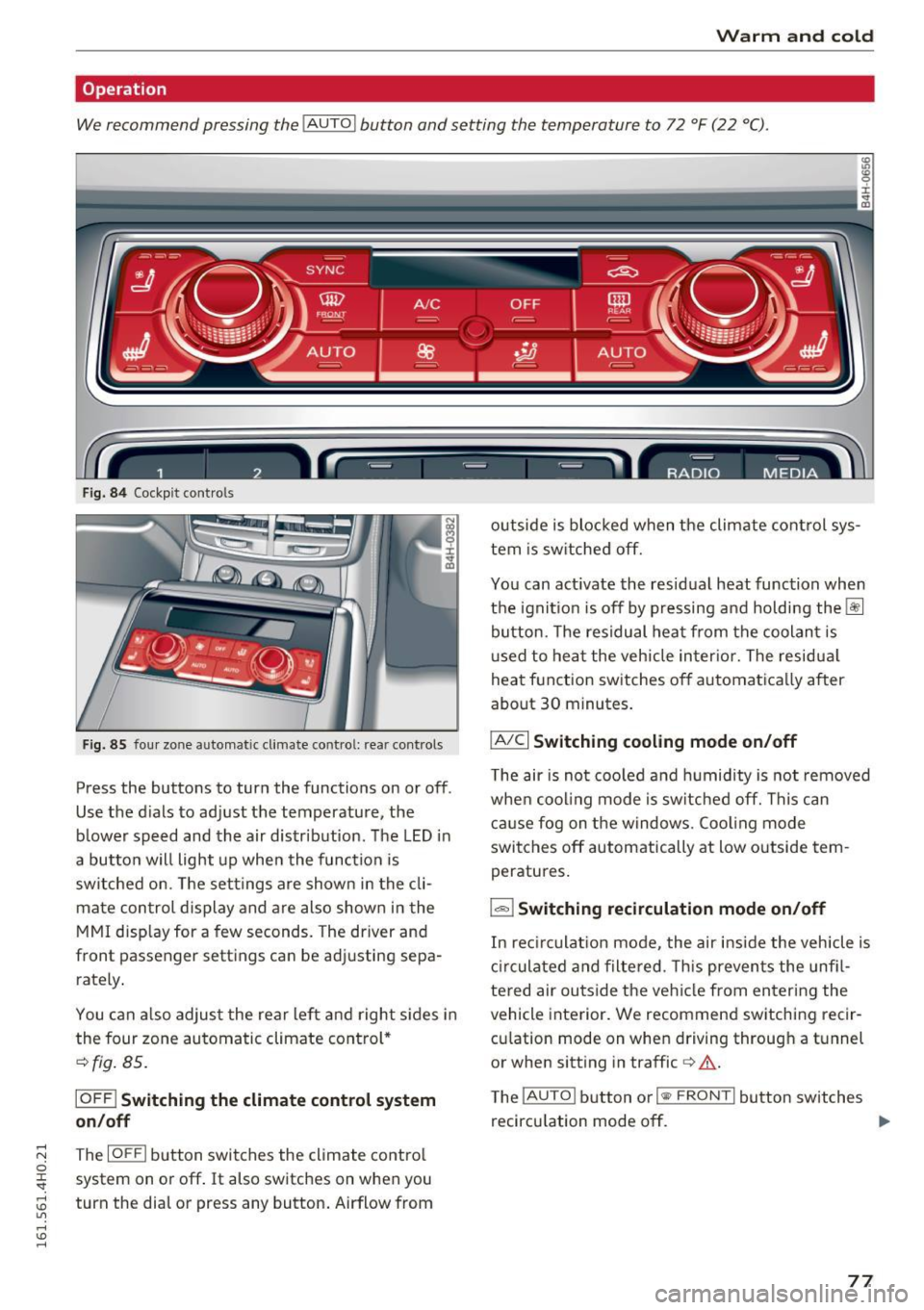
Warm and cold
Operation
We recommend pressing the
! AUTO ! button and setting the temperature to 72 °F (22 °C).
Fig. 84 Cockpit con trols
Fig. 85 four zone automatic climate control: rear controls
Press the buttons to turn the functions on or off .
Use the dials to adjust the temperature, the
b lower speed and the air distr ibut ion. The LED in
a butto n will light up when the function is
switched on. The settings a re shown in the cli
mate con trol display and are also shown in the
MMI disp lay for a few seconds. The driver and
front passenger settings can be adj usting sepa
rately .
You can also adjus t the rear left and right sides in
the four zone automatic climate control*
¢fig. 85 .
IOFF I Switching the climate control system
on/off
~ The IOFFI button switches the climate control 0
~ system on or off. It also switches on when you
~ turn the dial or press any button. Airflow from U"I ,...., \!) ,....,
outside is blocked when the climate control sys
tem is switched off.
You can act ivate the residual heat function when
the ignit io n i s off by pressing and holding the~
button. The residual heat from the coolant is
u sed to heat the veh icle inter ior. The residua l
heat function switches off automatica lly after
about 30 minutes .
IA/Cl Switching cooling mode on/off
The air is not cooled and humidity is not removed
when cooling mode is switched off. This can
cause fog on the windows. Coo ling mode
switches off automatically at low outside tem
peratures.
1 .,.,,1 Switching recirculation mode on/off
In rec irculat ion mode, the air inside the vehicle is
circulated and filtered. This prevents the unfi l
tered air outside the vehicle from entering the
vehicle interior. We recommend switching recir
cu lation mode on when driving through a tunnel
or when sitting in traffic
c> &.
The !AUTO I button or I
recircu lation mode off. ..,.
77
Page 80 of 302
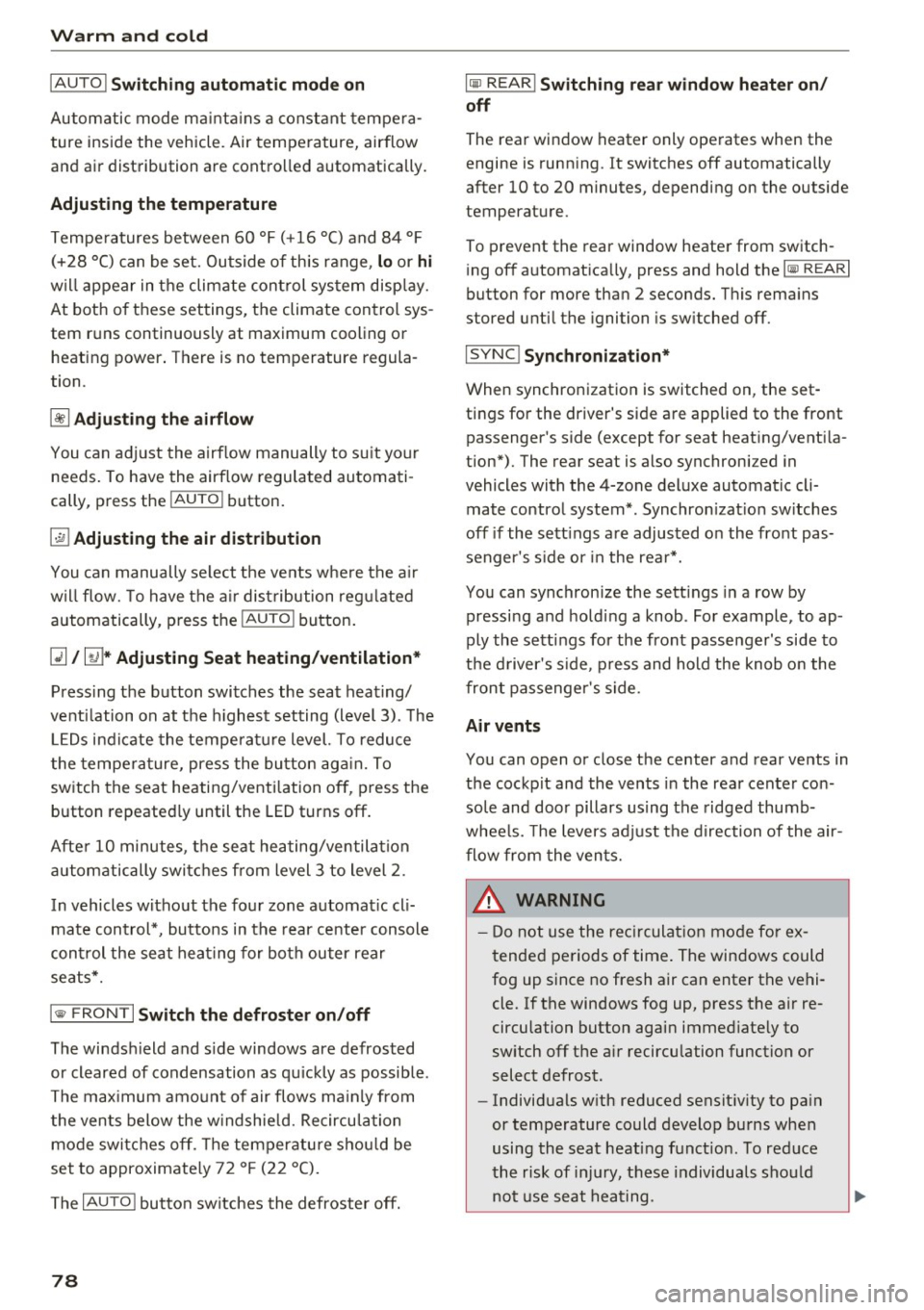
Warm and cold
IAUTO ! Switching auto matic mode on
Automatic mode ma intains a constant tempera
ture inside the vehicle. Air temperature, airflow
and air distribution are cont rolled automatically.
Adjusting th e tempe rature
Tempe ratures between 60 °F (+16 °C) and 84 °F
(+28 °C) can be set. Outside of this range,
l o or hi
will appear in the climate control system disp lay.
At both of these settings, the climate control sys
tem runs continuously at maximum cooling or
heating power . There is no temperature regula
tion .
~ Adjust ing th e airflo w
You can adjust the airf low manually to suit your
needs . To have the airflow regulated automati
cally, press the
IAU TO I button.
~ Adjusting the air distribution
You can manually se lect the vents where the a ir
will flow. To have the a ir dist ribution reg ulated
automatically, press the
IAU TO I button.
[ti /~ * Adjusting Seat h eating /v entil ation *
Pressing the button switches the seat heating/
venti lation on at the h ighest setting (level 3) . The
L EDs indicate the temperature level. To reduce
the tempera ture, press the button aga in. To
switch the seat heating/ventilation off, press the
button repeated ly until the LED turns off.
Afte r 10 minutes, the seat heating/ventilation
automatically switches from level 3 to level 2 .
In vehicles without the four zone automat ic cl i
mate control*, buttons in the rear center console
control the seat hea ting for both outer rear
seats*.
I @ FRONT I Switch th e defroster on /off
The windsh ield and s ide windows are defrosted
or cleared of condensation as qu ickly as possible .
The max imum amo unt of air flows ma inly from
the vents below the w indshield. Recircu lation
mode switches off. The temperature shou ld be
set to approximate ly 72 ° F (22 °C).
The
IAU TOI button switches the defroster off.
78
lliil REAR I Switch ing rear window he ater on /
off
The rear window heater only operates when the
engine is running . It switches off automatically
after 10 to 20 minutes, depending on the outside
temperature.
To prevent the rear window heater from switch
i ng off automatica lly, press and hold the
ICiJ REARI
button for more than 2 seconds. This rema ins
stored until the ignition is sw itched off.
I SYNC ! Synchroni zation *
When synchronization is switched on, the set
tings for the driver's side are applied to the front
passenger's side (except for seat heating/venti la
tion*). The rear seat is also synchroni zed in
vehicles with the 4-zone deluxe automatic cli mate control system*. Synchron izat ion sw itches
off if the sett ings a re adjusted on the front pas
senger's s ide or in the rear*.
You can synchronize the sett ings in a row by
pressing and holding a knob . For example, to ap
ply the settings for the front passenger's side to
the d river's s ide, press and hold the knob o n the
front passenger 's side.
Air vents
You can open or close the center and rear vents in
the cockpit and the vents in the rear center con
so le and doo r pillars us ing the ridged thumb
whee ls. The levers adj ust the direction of the air
flow from the vents.
_&. WARNING
- Do not use the rec irculat ion mode for ex
tended periods of time . The windows could
fog up since no fresh air can enter the vehi cle. If the windows fog up, press the air re
circulation button again immed iate ly to
sw itch off the a ir recircu lation function or
select defrost.
- Individuals w ith reduced sensit iv ity to pa in
or temperature could develop burns when
using the seat heating funct ion. To reduce
the risk of injury, these individuals should not use seat heating.
-
Page 95 of 302
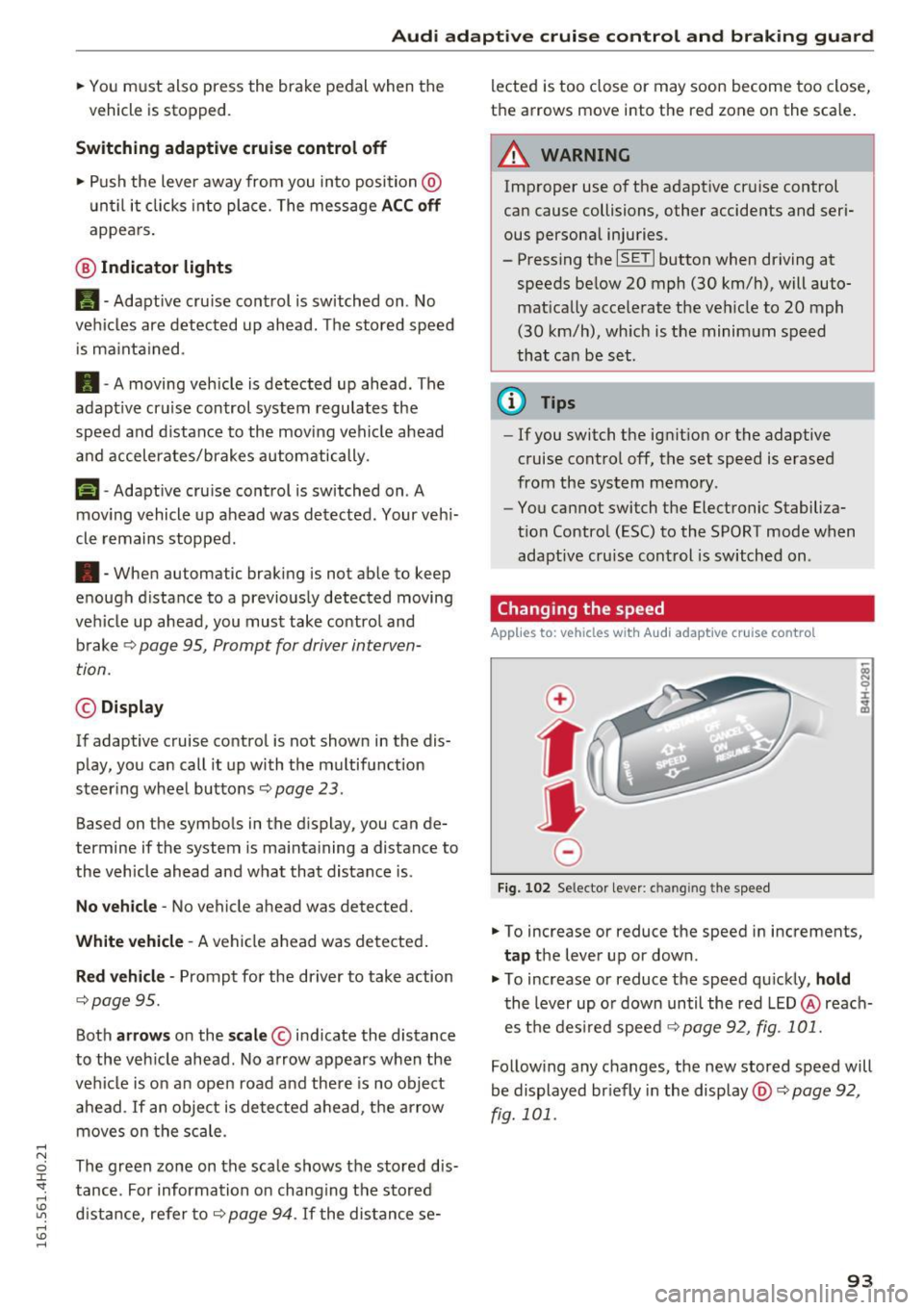
Audi adaptive cruise control and braking guard
.. You must also press the brake pedal when the
vehicle is stopped .
Switching adaptive cruise control off
.. Push the lever away from you into position @
until it clicks into place. The message
ACC off
appea rs.
@ Indicator lights
II-Adapt ive cru ise control is switched on . No
vehicles are detected up ahead. The stored speed
is ma inta ined .
• -A moving vehicle is detected up ahead . The
adapt ive cruise control system regulates the
speed and distance to the moving vehicle ahead
and accelerates/brakes automatically.
(-) -Adaptive cru ise control is switched on . A
mov ing vehicle up ahead was detected . Your veh i
cle remains stopped .
• -When automatic braking is not able to keep
enough d istance to a previously detected moving
veh icle up ahead, you must take control and
brake
c::> page 95, Prompt for driver interven
tion.
© Display
If adaptive cruise control is not shown in the dis
play, you can call it up with the multifunction
steer ing wheel buttons c::>
page 23.
Based on the symbols in the display, you can de
termine if the system is ma inta ining a distance to
the vehicle ahead and what that distance is.
No vehicle -No vehicle ahead was detected.
White vehicle -A vehicle ahead was detected.
Red vehicle -Prompt for the driver to take action
c::>page 95.
Both arrows on the scale © indicate the distance
to the vehicle ahead. No arrow appears when the
vehicle is on an open road and there is no object
ahead . If an object is detected ahead, the arrow
moves on the scale .
The green zone on the scale shows the stored dis
tance . For information on chang ing the stored
distance, refer to
c::> page 94. If the distance se-lected is too
close or may soon become too close,
the arrows move into the red zone on the scale .
A WARNING
Improper use of the adaptive cruise control
can cause collisions, other accidents and seri
ous personal injuries.
- Pressing the
ISETI button when driving at
speeds below 20 mph (30 km/h), will auto matically accelerate the ve hicle to 20 mph
(30 km/h), which is the minimum speed
that can be set.
(D Tips
-If you switch the ignit ion or the adaptive
cruise control off, the set speed is erased
from the system memory .
- You cannot switch the Electronic Stabiliza
tion Control (ESC) to the SPORT mode when
adaptive cruise control is switched on .
Changing the speed
Applies to: vehicles with Aud i adapt ive cru ise control
0
f
•
0
Fig. 102 Selector lever: chan gin g t he speed
.. To increase or reduce the speed in increments,
tap the lever up or down .
.,. To increase or reduce the speed quickly,
hold
the lever up or down until the red LED@reach
es the desired speed c::>
page 92, fig. 101.
Following any changes, the new stored speed will
be displayed br iefly in the display @c::>
page 92,
fig. 101 .
93
Page 102 of 302
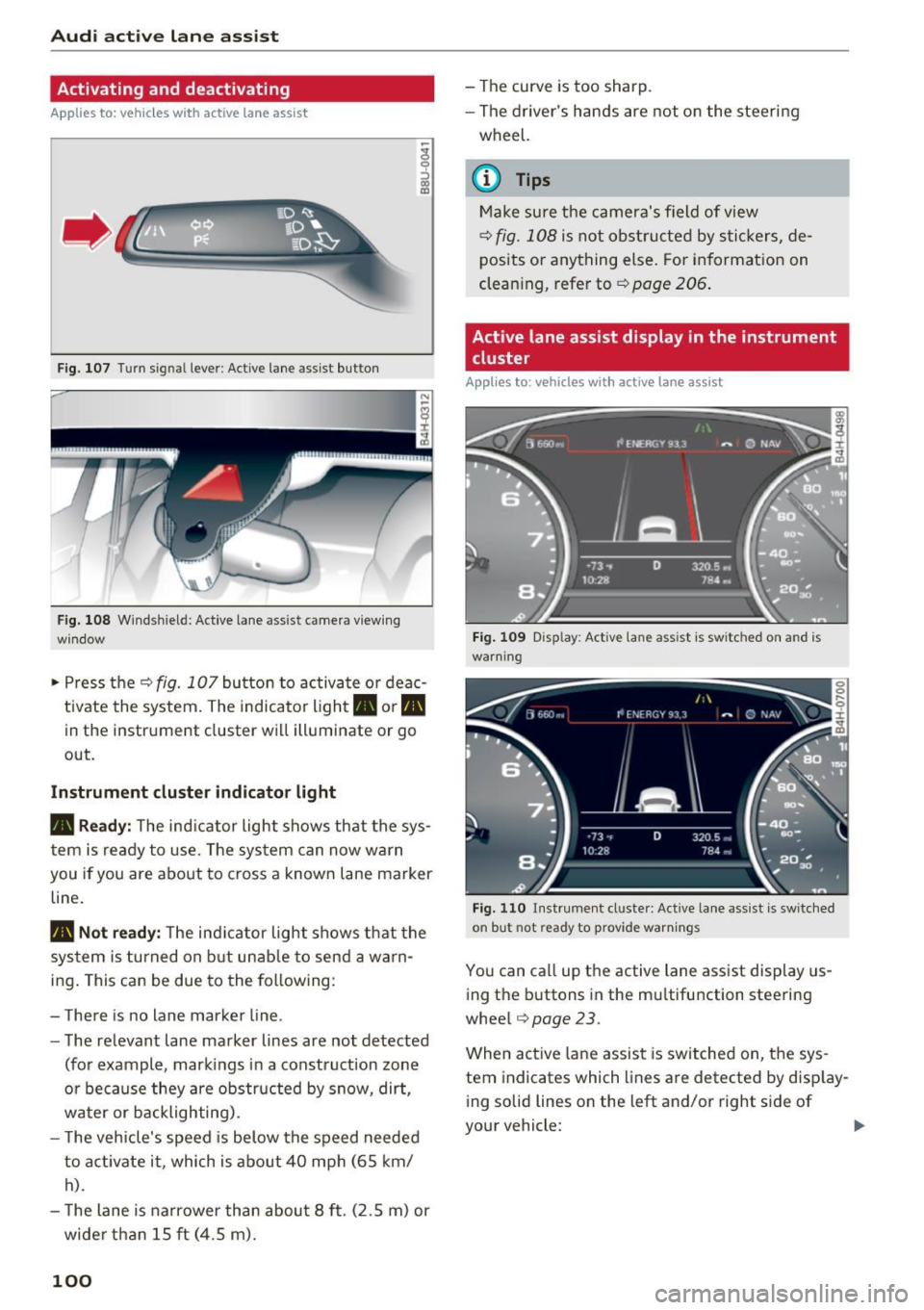
Audi active lane assist
Activating and deactivating
Applies to: vehicles with active lane assist
Fig. 107 Turn sign al lever : Active lane assist button
Fig. 108 Windshiel d: Active lane assist came ra viewing
window
• Press the r=;, fig. 10 7 button to activate or deac
tivate the system. The indicator light. or
Pit
in the instrument cluster will illuminate or go
out.
Instrument cluster indicator light
• Ready:
The ind icator light shows that the sys
tem is ready to use. The system can now warn
you if you are about to cross a known lane marker
line.
Pit Not ready: The ind icator light shows that the
system is turned on but unable to send a warn
ing . This can be due to the following :
- There is no lane marker line.
- The relevant lane marker lines are not detected
(for example , mark ings in a construct ion zone
o r because they are obstructed by snow, dirt,
water or backlighting).
- T he vehicle's speed is below the speed needed
to activate it , which is about 40 mph (65 km/
h).
- The lane is narrower than about 8 ft. (2.5 m) or
wide r than 15 ft (4.5 m).
100
- The curve is too sharp.
- The driver's hands are not on the steering
wheel.
{i) Tips
Make sure the camera's field of view
r=;, fig. 108 is not obstructed by stickers, de
posits or anything else. For information on
cleaning, refer to¢
page 206.
Active lane assist display in the instrument
cluster
Appl ies to : vehicles with active lane assist
Fig. 109 Disp lay : Activ e lane ass ist is switc hed on a nd is
warn ing
Fig. 110 Instrument cl uste r: Active lane as sis t is sw itched
on but hot ready to provide warnings
You can call up the active lane assist display us
i ng the buttons in the multifu nction steering
wheel
r=;, page 23.
When active lane assist is switched on, the sys
tem indicates which lines are detected by display
i ng solid lines on the left and/or right side of
your vehicle:
Page 111 of 302

Night vision assistant
Night vision assistant
with pedestrian and wild animal marking
Description
Applies to: vehicles with night visio n ass istant
Night vision assistant with pedestrian and wild
animal detection assists you in darkness by using
an infrared camera to monitor the area in front of
your veh icle , w ith in the limits of the system .
It
can display objects up to app roximately
1000 feet (300 meters) away. The hea t image
detected by the camera is shown in the instr u
ment cluster display. Warm areas appea r lighter
and cold areas appear darker.
Pedestrian and wild animal detection
Applies to: vehicles with night vision assistant
Fi g. 117 D is play: ye ll ow pede strian mark ing
Fi g. 118 D is p lay : symbo l w hen infrared ima ge is not vi sible
W ith in the limits of the system, n igh t vis io n as
sistant can detect pedestrians and wild animals
that are w ithin the detection range between ap
proximate ly 32 feet (10 meters) and 295 feet
(90 meters) in front of the vehicle. When it is
dark outside and the headlights are sw it ched on,
Night visi on assis tant
detected pedestrians and w ild animals a re
marked in ye llow ¢
fig. 117 with in the limits of
the system
¢ page 110 . Wild anima l detect ion is
not act ive in bu ilt-up areas. The system only de
tects large wi ld animals such as deer .
(!_) Tips
-If another display such as navigation rep la
ces the image from the night vision assis
tant, the~,, symbol appears in the tab
¢
fig . 118. You can call up n ight v is ion as
sistant using the buttons on the m ultifunc
tion steering wheel¢
page 24 .
Pedestr ian and wild animal warning
Applies to: vehicles with nigh t vision assistant
Fi g. 119 In strument cl uste r: @ pedes trian w arnin g, @
w ild a nima l warn ing
F ig . 1 20 In strum en t cluste r: @ ped estr ian wa rnin g/ @
w ild an ima l warn ing w hen the n ig ht v is ion ass istant image
i s not se lected in the instr um ent cl uste r d isp lay
Instrument cluster display /Head-up Display*
If pedestrians o r wild animals are detected in an
area in front of your vehicle th at is considered
critical, the system will attempt to draw your at-
tention to this by :
Ill-
109
Page 183 of 302
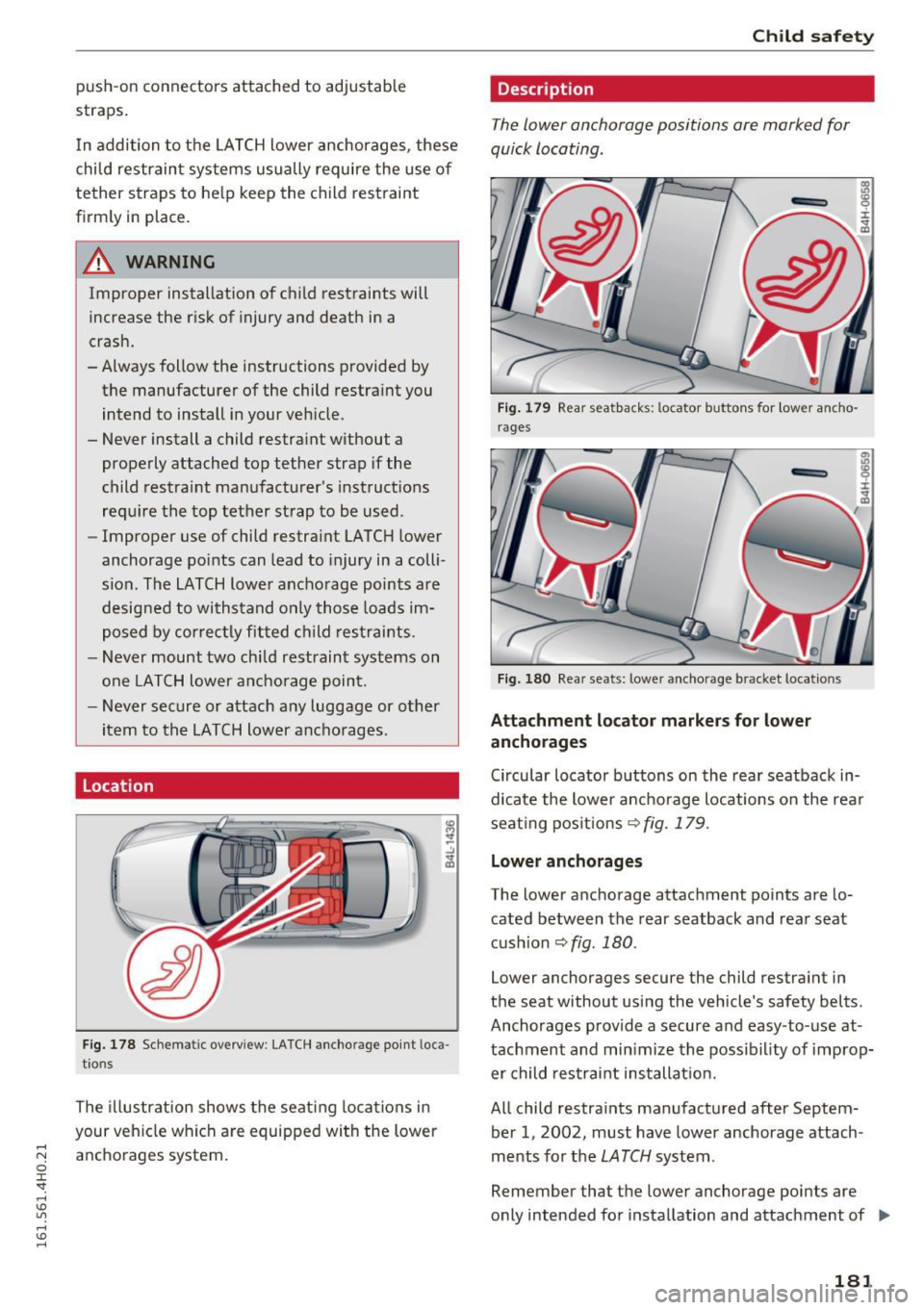
push-on connectors attached to adjustable
straps .
I n addition to the LATCH lower anchorages, these
child restraint systems usually require the use of
tether straps to h elp keep the child restraint
firm ly in place.
A WARNING
Improper installation of child restraints will
increase the risk of injury and death in a
crash.
- Always follow the instructions provided by the manufacturer of the child restra int you
intend to install in your veh icle.
- Never install a child restra int w ithout a
properly attached top tether strap if the
child restraint manufacturer's instruct ions
requ ire the top tether strap to be used .
- Improper use of child restra int LATCH lower
anchorage po ints can lead to injury in a colli
sion. The LATCH lower anchorage points are designed to withstand only those loads im
posed by correc tly fit ted child res traints .
- Never mount two chi ld restraint systems on
one LATCH lower anchorage poin t.
- Never secure or attach any luggage or other
item to the LATCH lower anchorages .
Location
F ig. 178 Sche matic overv ie w : LA TCH an ch orag e point loc a
t io ns
The illustration shows the seating locations in
your veh icle which a re equipped with the lower
ancho rages system.
Ch ild sa fety
Description
The lower anchorage positions are marked for
quick locating .
Fig . 1 79 Rear seatbacks: loca tor bu tto ns for low er an cho
r ages
Fi g. 180 Rea r seat s: lowe r anchorage bracket lo ca tion s
Att achment lo cator markers for lower
anchorages
:r
~ (
Circular locator buttons on the rear seatback in
dicate the lower anchorage locations on the rear
seating pos itions
Q fig . 179.
Lower anchorages
The lower anchorage attachment points are lo
cated between the rear seatback and rear seat
cush ion
c::> fig. 180 .
Lower anchorages secu re the child res traint in
the seat without using the vehicle's safety belts .
Anchorages provide a secure and easy -to -use at
tachment and min imize the possibility of improp
er child restraint installat ion.
All child restra ints manufactured after Septem
ber 1 , 2002, must have lower anchorage attach
ments fo r the
LATCH system .
Remember that the lower anchorage points are
only intended for installation and attachment of .,_
181
Page 271 of 302
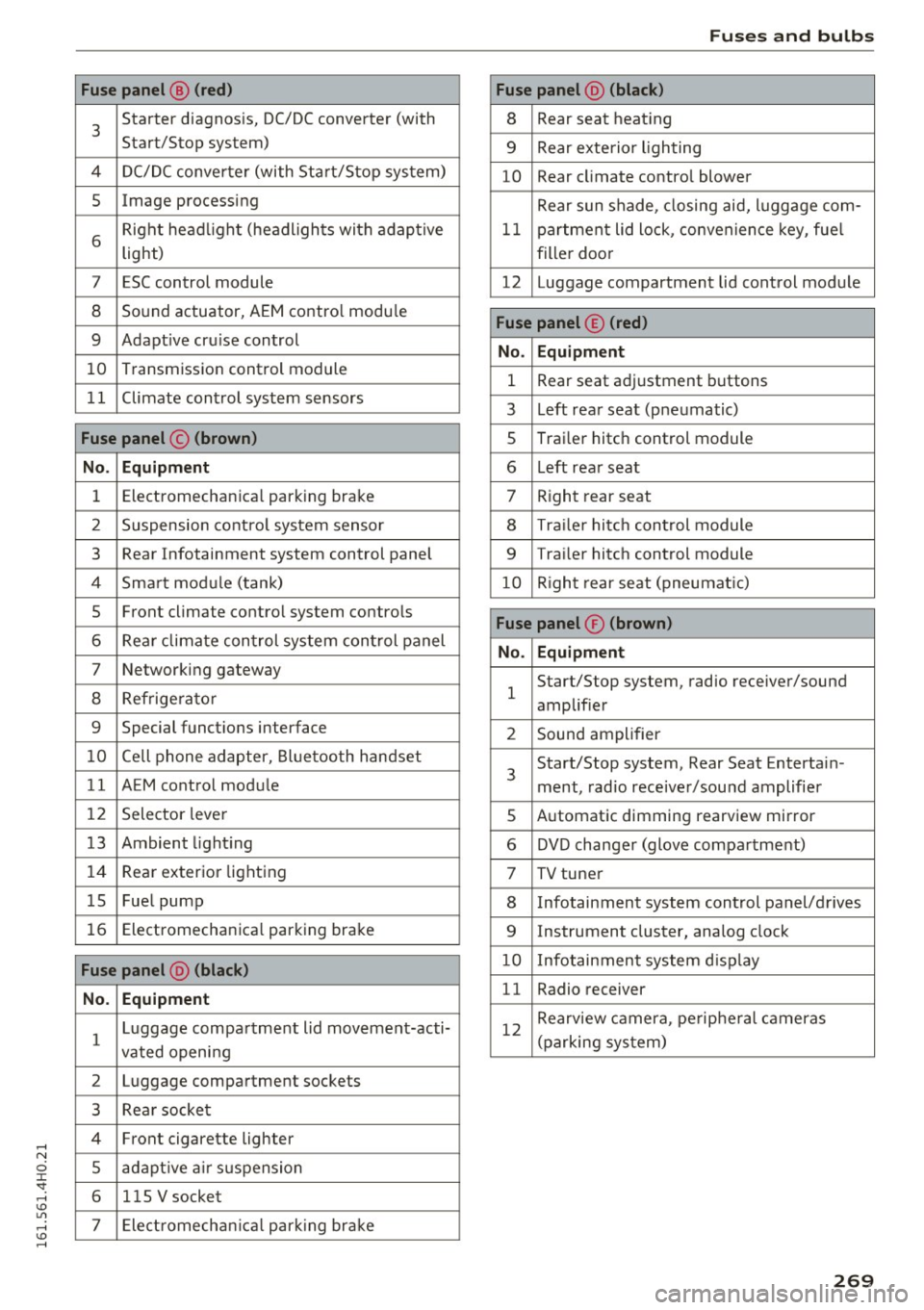
Fuses an d bulb s
Fuse p anel @ (red ) Fuse panel@ (black )
3 Starter diagnosis, DC/DC converter (with
Start/Stop system) 8 Rear
seat heating
9 Rear exterio r lighting
4 DC/DC converter (with Start/Stop system)
10 Rear
climate contro l blower
5 Image processing
Rear sun shade, closing aid, luggage com-
6 Right headl
ight (headlights with adaptive
light) 11 partment lid
lock, convenience key, fue l
filler doo r
7 ESC control module 12 Luggage compartment lid control module
8 Sound actuator, AEM control modu le
9 Adapt ive cru ise control
10 Transmission
control module
Fuse panel © (red )
No . Equ ipm en t
1 Rear seat adjustment buttons
1 1 Climate control system sensors
3 Left rear
seat (pneumatic)
Fuse panel © (br own ) 5 Trai
ler hitch control module
No. Equipm ent 6 L
eft rear seat
1 Electromechanical parking
brake
7 Right rear seat
2 Suspension control system sensor
8 Traile r hitc h control module
3 Rear Infotainment system control
panel
9 Trailer hitch control module
4 Smart module (tank) 10 Right rear seat (pneumatic)
5 Front climate contro
l system controls
6 Rear climate control system control panel
7 Networking gateway
8 Refrige rator
Fuse panel ® (brown )
No. Equipm en t
1 Start/Stop
system, radio receiver/sound
amplifier
9 Special functions interface
2 Sound amplifier
10 Cell phone adapter, Bluetooth handset
11 AEM control module 3 Start/Stop
system, Rear Seat Entertain-
ment, radio receiver/sou nd amplifier
12 Selector lever
5 Automatic dimming
rearview mirror
13 Ambient lighting 6 DVD changer (glove compa rtment)
14 Rear
exterior lighting
7 TV tuner
15 Fuel pump
8 Infotainment system control panel/drives
16 Electromechanica l parking brake
9 Instrument cluster, analog clock
Fuse panel @ (bl ack ) 10 Infotainment system d isp lay
N o. Equi pm en t 11 Radio receiver
1 Luggage compartment lid movement-acti-
vated openi ng 12
Rearview camera, pe
ripheral cameras
(parking system)
2 Luggage compartment sockets
3 Rear socket
4 Front cigarette lighter
5 adapt ive a ir suspension
6 115 V
socket
7 Electromechan ica l park ing brake
269
Page 297 of 302

Spare tire
refer to Compact spare tire . . . . . . . . . . . . 257
Spare wheel . . . . . . . . . . . . . . . . . . . . . . . . . 258
Speedometer . . . . . . . . . . . . . . . . . . . . . . . . . 26
Speed warning system . . . . . . . . . . . . . . . . . . 88
Sport differential . . . . . . . . . . . . . . . . . . . . . 106
Indicator light . . . . . . . . . . . . . . . . . . . . . . . 22
Start-Stop-System . . . . . . . . . . . . . . . . . . . . . 85
Engine does not switched off . . . . . . . . . . . 86
E ngine starts automatically . . . . . . . . . . . . 86
Indicator lights . . . . . . . . . . . . . . . . . . . . . . 86
Messages . . . . . . . . . . . . . . . . . . . . . . . . . . . 87
Starting/stopping the engine . . . . . . . . . . . 86
switch ing off/on . . . . . . . . . . . . . . . . . . . . . 87
Start/Stop system . . . . . . . . . . . . . . . . . . . . . 85
S TART ENGINE STOP button . . . . . . . . . . . . . 81
Starting from rest . . . . . . . . . . . . . . . . . . . . . . 84
St art ing off with a trailer . . . . . . . . . . . . . . . . 85
Starting (engine) . . . . . . . . . . . . . . . . . . . . . . 81
Steering
refer to Electromechanical power assist. . 194
Steering whee l
Adjusting steering column . . . . . . . . . . . . . 80
Buttons . . . . . . . . . . . . . . . . . . . . . . . . . . . . . 24
Easy entry feature . . . . . . . . . . . . . . . . . . . . 80
Indicator light ................ ... 17, 194
Shift paddles . . . . . . . . . . . . . . . . . . . . . . . 115
Steer ing whee l heating . . . . . . . . . . . . . . . . 79
Steps for determining correct lo ad limit . . . 250
Stopping the engine . . . . . . . . . . . . . . . . . . . . 81
Storage compartments . . . . . . . . . . . . . . . . . 73
Sunroof . . . . . . . . . . . . . . . . . . . . . . . . . . . . . . 42
Panorama glass roof . . . . . . . . . . . . . . . . . . 43
Sun shades Em ergency closing (roof) . . . . . . . . . . . . . . . 44
Panoramic sunroof. . . . . . . . . . . . . . . . . . . . 44
Rear doors . . . . . . . . . . . . . . . . . . . . . . . . . . 53
Rear window . . . . . . . . . . . . . . . . . . . . . . . . . 53
Sun visors . . . . . . . . . . . . . . . . . . . . . . . . . . . . 53
Symbols
refer to Warning/Indicator lights.. .... .. 11
T
Tachometer .................... .... 11, 23
T ail lights
Cleaning . . . . . . . . . . . . . . . . . . . . . . . . . . . 207
Index
TOI clean diesel
refer to Ad Blue ... .. ................ . 216
Technical data . . . . . . . . . . . . . . . . . . . . . . . . 277
Technical modifications . . . . . . . . . . . . . . . . 283
T emperature display . . . . . . . . . . . . . . . . . . . 23
Tether anchors . . . . . . . . . . . . . . . . . . . . . . . 184
Tether strap . . . . . . . . . . . . . . . . . . . . . . . . . 184
T extiles
Cleaning . . . . . . . . . . . . . . . . . . . . . . . . . . . 209
Tie -downs . . . . . . . . . . . . . . . . . . . . . . . . 68, 136
Tips for the environment
Saving fuel . . . . . . . . . . . . . . . . . . . . . . . . . . 71
t iptronic (automatic t ransm iss ion) . . . . . . . 112
Tire mobility kit . . . . . . . . . . . . . . . . . . . . . . 256
Tires . . . . . . . . . . . . . . . . . . . . . . . . . . . . . . . . 236
Low aspect ratio tires . . . . . . . . . . . . . . . . 252
Repair set . . . . . . . . . . . . . . . . . . . . . . . . . . 256
Replacing . . . . . . . . . . . . . . . . . . . . . . . . . . 259
Service life . . . . . . . . . . . . . . . . . . . . . . . . . 244
Tire pressure . . . . . . . . . . . . . . . . . . . . . . . 246
Tire pressure monitoring system . . . . . . . 254
T ire pressure table . . . . . . . . . . . . . . . . . . . 247
T readwear indicators . . . . . . . . . . . . . . . . . 244
Unidirectional. . . . . . . . . . . . . . . . . . . . . . . 238
Uniform tire quality grading . . . . . . . . . . . 253
Tires and wheels
Glossary of tire and loading terminology . 238
T ires and vehicle load limits . . . . . . . . . . . 248
Tool . . . . . . . . . . . . . . . . . . . . . . . . . . . . . . . . 256
Torn or frayed safety belts . . . . . . . . . . . . . . 140
T owing
T ow trucks . . . . . . . . . . . . . . . . . . . . . . . . . 273
TPMS (tire pressure moni toring system) . . . 254
Trailer mode . . . . . . . . . . . . . . . . . . . . . . . . . 202
Notes . . . . . . . . . . . . . . . . . . . . . . . . . . . . . 204
T railer towing
Operating instructions . . . . . . . . . . . . . . . . 202
Parking system . . . . . . . . . . . . . . . . . . . . . . 128
T echnica l requirements . . . . . . . . . . . 202, 203
Train (transporting your vehicle) ......... 274
Transmission malfunction (indicator light). 116
T ransport Canada . . . . . . . . . . . . . . . . . . . . . 137
Transporting your vehicle ............ ... 274
Trip odometer . . . . . . . . . . . . . . . . . . . . . . . . . 26
What does it mean wh en DEF appears in the
trip odome ter disp lay? . . . . . . . . . . . . . . . . 26
295